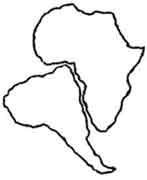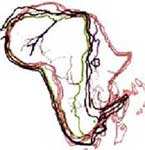|
Alfred Wegener suggested that South America and Africa were once joined
together.

Wegener proposed the existence of a proto-continent, which he called,
Pangaea. That supposedly occurred over 200 million years ago. The proto-continent
broke up and the continents, that we see today, wandered across the face
of the Earth to where they now relatively drift.
Were the above to be the case, one would not suspect these two continents
to share any symmetrical characteristics in their make-up, other than
along the dividing line. In fact, one might expect them to represent two
halves of a whole. And, if any translation symmetry in their configuration
were to be found, then, we might be able to suggest a distinct interpretation
to that offered by Wegener.
The meandering ways of the
continents suggest a random-like configuration. It is difficult to believe
that the continents traveled over 5000 kilometers on the face of the Earth,
and still retain their nearly original shape. We examine the translation
symmetry.

In order to find the translations symmetry between South
America and Africa, one must not merely examine the visible outline
above water. One must examine their underwater, continental-shelf
structures. At that level of comparison, all kinds of symmetries
appear. The northwestern tips of both continents coincide; the
eastern rim of South America coincides with the line marked by
the Nile River of Africa; and, the southeastern tips of both continents
reflect a correspondence at the level of their shelves.
Add to that factors like the Earth's ecliptic, the prime meridian,
and the equator, and we begin a distinct view of the energies
in and about the Earth that configured the continents and the
tectonic plates.
©2001-2014 Copyrighted by Charles William Johnson.
All rights reserved. Reproduction prohibited.
|
|
|
EVENTPOINT COSMOGEOGRAPHY
Eventpoint Cosmogeography, a new study,
opens up a distinct line of inquiry into the geography of
the Earth. Charles William Johnson, from Earth/matriX,
Science Today, questions the theory of continental drift
by examining the distances between geographical extreme
points and selected cosmogeographical event points. The
translation and centrosymmetries of geographical coordinate
points suggest the fact that the continents undergo movement,
but that they have not drifted randomly on the face of the
Earth for the past 250 million years as proposed by Alfred
Wegener nearly a century ago. The symmetry between extremepoints
and eventpoints illustrated in this study suggests that
continental drift theory must be reconsidered, possibly
abandoned.
Volume One
Eventpoint Cosmogeography
A Study in Relating Event Point Cosmogeography and Extreme Point Geography
Earth/matriX Editions ISBN 1-58616-432-5
Purchase and download Volume One in a PDF file
281 Pages
Fully illustrated with drawings.
Price: $9.95US

Volume Two
Eventpoint Cosmogeography
The Earth's Crust-Mantle-Core Boundaries and Mean Plane of Motion
Earth MatriX Editions ISBN 1-58616-458-9
Purchase and download Volume Two a PDF file
354 Pages
Price: $9.95

Volume Three
The Mean Plane of Motion and the Crust-Mantle-Core Boundaries of Earth
Purchase and Download Eventpoint Cosmogeography Volume Three PDF-file
248 pages Price: $7.95us

|
Earth/matriX: Science in Ancient Artwork & Science Today
P.O. Box 231126, New Orleans, Louisiana, USA, 70183-1126
johnson@earthmatrix.com
|

